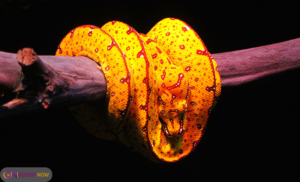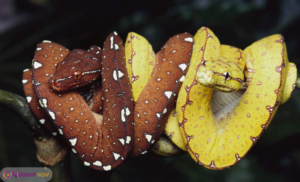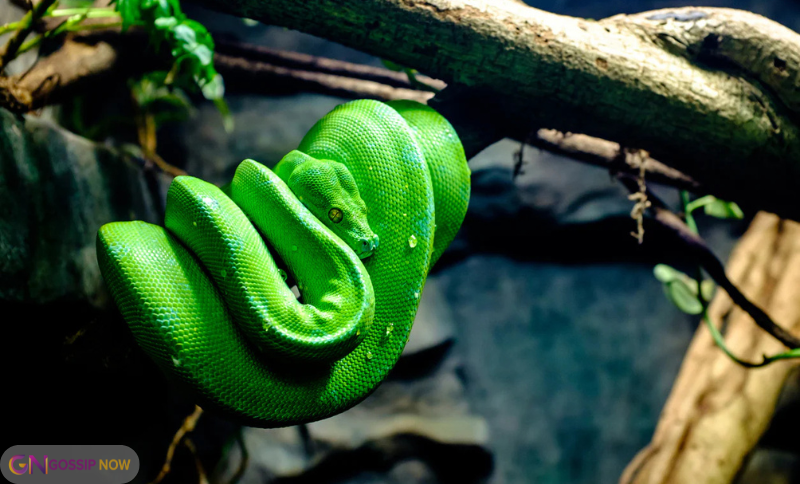The green tree python is a captivating snake species known for its striking color and arboreal lifestyle. Whether you’re a reptile enthusiast or a curious beginner, you’ll quickly understand why the green_tree_python has become a favorite among collectors and herpetologists alike. With its vivid hues and mesmerizing coils, this snake is more than just a pet—it’s a living work of art.
But before bringing one home, there’s a lot you need to know. From its care needs and feeding habits to questions like “Is the green_tree_python poisonous?” or “What about green tree python teeth?”—this guide has you covered.
What Is a Green Tree Python?
 The green_tree_python (Morelia viridis) is a non-venomous snake native to the rainforests of New Guinea, Indonesia, and the Cape York Peninsula in Australia. Unlike most snakes, it spends the majority of its life in trees. Its body is adapted for this lifestyle, often draped gracefully over branches in a classic “S” shape.
The green_tree_python (Morelia viridis) is a non-venomous snake native to the rainforests of New Guinea, Indonesia, and the Cape York Peninsula in Australia. Unlike most snakes, it spends the majority of its life in trees. Its body is adapted for this lifestyle, often draped gracefully over branches in a classic “S” shape.
What makes them even more intriguing is their wide range of color morphs—especially the high blue green tree python and the increasingly popular purple green_tree_python.
Green Tree Python Size and Appearance
When it comes to size, the green_tree_python typically grows to about 4 to 6 feet in length. Males are usually smaller and more slender than females. Their vivid coloration often starts in neon yellow or brick red when young and gradually shifts to a brilliant green as they mature.
Popular Color Morphs:
-
High Blue Green Tree Python: Known for its bluish sheen over the green scales.
-
Purple Green Tree Python: A rare and visually stunning morph with hints of lavender or deep violet.
These morphs are not only eye-catching but also command a premium in the exotic pet market.
Green Tree Python Habitat
In the wild, green_tree_pythons thrive in tropical rainforests, where high humidity and warm temperatures are constant. They’re often found:
-
High in tree canopies
-
Along riverbanks
-
In dense foliage
In Captivity:
To mimic their natural environment, you must maintain:
-
Temperature: 78°F to 88°F (day), with a slight drop at night
-
Humidity: 50%–70%, boosted through misting and live plants
-
Enclosure: Vertical space with sturdy branches is crucial
Without a properly set-up habitat, even a healthy snake can become stressed or ill quickly.
Green Tree Python Care
Caring for a green_tree_python requires commitment and attention to detail. Although beautiful, they are not beginner snakes. Their environment must be carefully maintained, and their temperament can vary.
Essential Care Tips:
-
Housing: Tall enclosures with perches and foliage for climbing and hiding.
-
Humidity Control: Use a hygrometer and mist twice daily.
-
Lighting: UVB isn’t essential, but proper lighting helps regulate their day-night cycle.
-
Handling: Minimal is best. These snakes are best observed, not frequently handled.
Due to their sensitive skin and strong feeding responses, improper handling can lead to stress or injury—for both you and the snake.
Green Tree Python Diet
Now, let’s talk about feeding. The green_tree_python diet is carnivorous, with a strong preference for small mammals and birds.
In the Wild:
-
Rodents
-
Frogs
-
Lizards
-
Small birds
In Captivity:
-
Pre-killed mice or rats (sized appropriately)
-
Juveniles: Feed once every 5–7 days
-
Adults: Feed once every 10–14 days
Avoid overfeeding, as it can lead to obesity and health issues. Always provide fresh water and monitor the snake’s body condition regularly.
Green Tree Python Teeth: What You Need to Know
You might be wondering, “Do green_tree_pythons have teeth?” Yes, and they’re sharp and backward-curving. These specialized teeth help them grip prey tightly and swallow it whole.
While the green tree python teeth aren’t venomous, a bite can be painful. It’s not deadly, but the wound may bleed and require cleaning. Hence, many keepers use a hook or tube method for moving their snake when needed.
Are Green Tree Pythons Poisonous or Venomous?
Let’s clear the air—green_tree_pythons are neither poisonous nor venomous. They are constrictors, which means they kill prey by coiling around it and squeezing until the animal can no longer breathe.
So while a bite may hurt, it’s not medically dangerous (unless infected). Always approach with respect and care, especially during feeding time when they may strike out of instinct.
Quick Recap: Green Tree Python at a Glance
 Here’s a quick summary of everything you need to know about the green_tree_python:
Here’s a quick summary of everything you need to know about the green_tree_python:
| Trait | Description |
|---|---|
| Scientific Name | Morelia viridis |
| Length | 4–6 feet |
| Lifespan | 15–20 years |
| Temperament | Defensive, not beginner-friendly |
| Habitat | Tropical rainforests (arboreal) |
| Diet | Carnivorous (mice, birds) |
| Poisonous/Venomous? | No |
| Teeth | Sharp and curved, non-venomous |
| Price | $400 – $3,000+ depending on morph |
Green Tree Python Price: What to Expect
The green_tree_python price can vary dramatically depending on factors like age, morph, and breeder reputation.
Average Price Range:
-
Standard Morphs: $400 – $800
-
High Blue Morphs: $1,000 – $2,000+
-
Purple Morphs: $3,000 and above (due to rarity)
Although expensive, these snakes are a long-term commitment—often living 15 to 20 years in captivity with proper care.
Personality and Behavior
Although visually calm, green_tree_pythons are often territorial and defensive. They’re not the kind of snake that enjoys being handled regularly. They prefer observing the world from a tree perch, coiled up and still.
Behavioral Traits:
-
Nocturnal: Active mainly at night
-
Territorial: They don’t like being disturbed
-
Striking Pose: Head pulled back in an “S” shape before lunging (common before a bite)
They’re more of a “display pet”—meant to be appreciated from a distance.
Author Bio Table
| Name | Dr. Elisa Ford |
|---|---|
| Profession | Herpetologist, Reptile Specialist |
| Experience | 12+ Years in Exotic Animal Husbandry |
| Notable Work | Reptile expos, published snake guides |
| Location | San Diego, California |
| Social | @reptilequeen_elisa (Instagram) |
Conclusion
In conclusion, the green tree python is a visually stunning and biologically fascinating creature. From its bright green body and piercing eyes to the rare and exotic high blue and purple morphs, it’s easy to see why these snakes captivate herpetology fans around the world.
However, with that beauty comes responsibility. These snakes require specific care, a dedicated environment, and a patient keeper. Whether you’re interested in the green tree python habitat, their feeding habits, or want to know more about green tree python teeth, this snake offers a deeply rewarding—but demanding—ownership experience.
If you’re looking to own one, make sure you’re ready to meet their needs. In return, you’ll gain a companion that truly feels like a piece of living art.
FAQs
1. Are green tree pythons poisonous or venomous?
No, green tree pythons are neither poisonous nor venomous. They are non-venomous constrictors.
2. How much does a green tree python cost?
Depending on the morph, a green tree python can cost anywhere from $400 to over $3,000.
3. What do green tree pythons eat?
Their diet consists of small mammals and birds, primarily pre-killed mice and rats in captivity.
4. Do green tree pythons have teeth?
Yes, they have sharp, curved teeth used to grip prey. While not venomous, their bite can be painful.
5. Are green tree pythons good pets?
They’re best for experienced keepers, as they can be defensive and require precise care.






